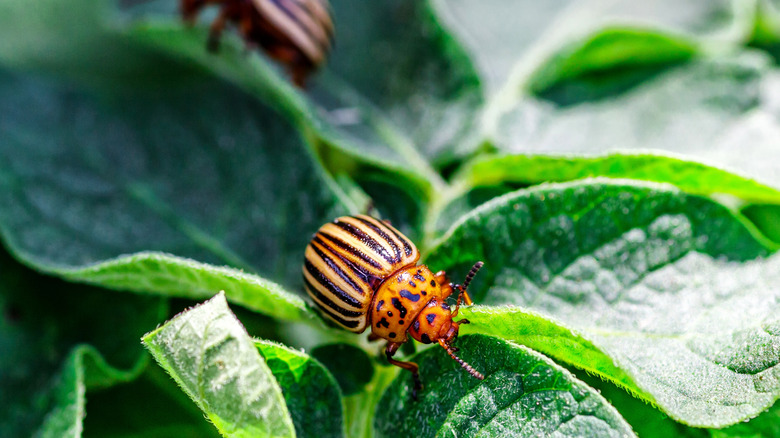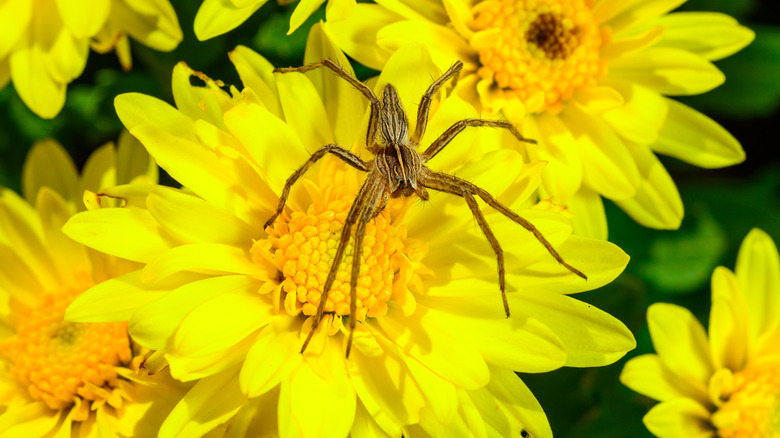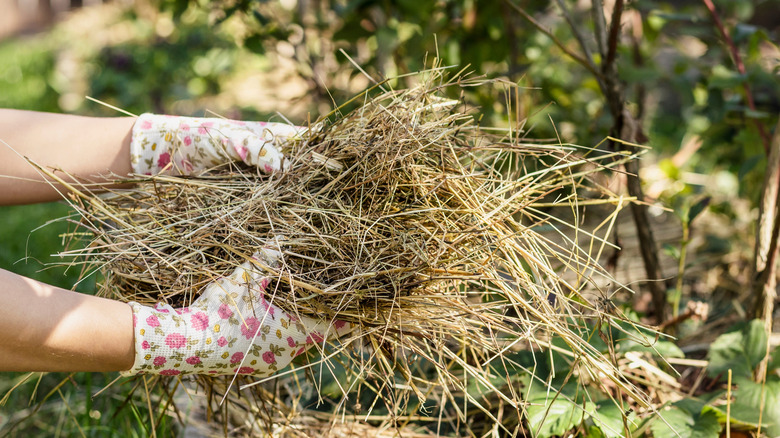The Best Ways To Stop Pesky Colorado Potato Beetles From Feasting In Your Garden
Have you noticed oblong, orange eggs congregating on the leafy undersides of your potato crop? Or maybe you've observed some fleshy grubs making meals of the foliage. They'll usually sport rows of black marks on their orange or tan bodies. In either case, you're probably dealing with Colorado potato beetles, a serious garden and agricultural pest. Leaving them unattended is usually one of the gravest, albeit common, mistakes that can limit your potato harvest. As they relish the green leaves, they deprive the crop of its ability to produce food, eventually killing it. Worse, they can also spread to other solanaceous crops, including eggplants, tomatillos, peppers, and tomatoes, decimating your vegetable garden.
Given the carnage these bugs can wreak at your vegetable beds, taking dedicated steps to stop Colorado potato beetles the moment you become aware of their presence is important. While there certainly are many methods to deal with this issue, hand-picking will get you the best results. If it proves impractical or inadequate because the area is too large or the pest outbreak has gotten out of hand, you must supplement your efforts with biological and chemical treatments. Once the infestation is under control, deploy preventative measures like crop rotation or switch over to early-maturing plant varieties.
Hand-picking and natural enemies
While we will admit handpicking beetles might not be your favorite gardening chore (and could very well rank worse than pruning), doing so is your best shot at stopping them from harming your veggies. Be sure to wear gloves — not just to get over the ick factor but because direct contact can leave your skin blistered. In early spring, scan the vegetable beds for adult beetles — they measure about ⅜ of an inch in length and display 10 black stripes across their pale yellow bodies (use BugGuide for ID). Pick them off along with their eggs and larvae, if the reproduction season is already underway, and crush or dunk them in soapy water. Repeat the procedure every couple of days. In especially hot climates, you can expect another round of infestation during mid-summer.
Additionally, strive to create a thriving ecosystem in your garden by growing flowers that attract beneficial insects to the garden, especially spiders, parasitic wasps, lady beetles, and stink bugs. They love cannibalizing beetles and colonizing their eggs. Some studies have also found positive results with Beauveria bassiana, a native, soil-dwelling fungus known to destroy harmful insects. Local garden stores often sell it as a contact mycoinsecticide (like Mycotrol). It's best applied as a liquid formulation (foliar spray), so you can completely drench the plant foliage. This biological agent works better during the early larval stages, so repeat applications will be necessary.
Chemical control and preventative measures
When hand-picking and biological control agents prove ineffective in putting a lid on the Colorado potato beetle problem, you may need to switch to full-strength chemical products, containing permethrin, esfenvalerate, or cyfluthrin. But if you would like a more organic approach, neem (azadirachtin) and spinosad-based products can prove effective. Be sure to follow the directives on the label for complete safety.
Going forward, take preventative measures to block Colorado potato beetles from harboring in your veggie beds. Remember, these bad guys are difficult to eliminate fully once they take over your yard but aren't fatally damaging so long you can keep the defoliation to under 30% during pre-flowering stages. To this end, be sure to remove any debris or yard waste in the winter where adult beetles could potentially hide. Keep the beds mulched, especially with straw, to inhibit their emergence the following year. With spring upon the winter's heels, kill weeds in your lawn, especially beetles' favorites, like nightshade and ground cherry.
If possible, skip growing solanaceous crops for a year. Without their favored food, the beetles will move elsewhere. Otherwise, in hot climates, switch over to early-maturing (under 80 days) potato varieties like Russet Norkotah, Red Pontiac, Dark Red Norland, or Yukon Gold. That way, you can harvest the crop before the second brood arrives. Or install row covers on emergent veggie seedlings to keep the bugs from laying eggs and retain them through mid-June.


